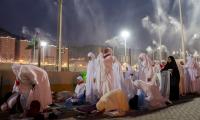Head of PPP Media Cell
Rounds of talk between US and Iranian officials have reportedly been held in Vienna this year with positive vibes for salvaging the Iranian nuclear deal signed in 2015 but ironically revoke by the former US President Trump in 2018. The incumbent US President Joe Biden however, has shown explicit inclination to restore the nuclear deal after making it ‘stronger and lasting’. His quest to make the Middle East Nuclear Free Zone and also stop Iran from enriching uranium to the weapon grade level lies in the heart of his strategic vision. The diplomatic circles believe that the underway indirect negotiations between the US and Iranian officials may succeed in restoring the nuclear deal because the political leadership of Washington and Tehran have been genuinely pushing it for the shared outcome. The probable success of the ongoing negotiations may certainly be preceded by lifting of sanctions on Iran by the US and others enabling the country to engage with the international community for the promotion of its trade, export of oil including undertaking financial transactions to boost its economy that had suffered badly due to the crippling sanctions imposed by former president Trump. The lifting of sanctions may also qualify Tehran to have access to the frozen assets worth hundred billions of dollars—enough to give jump start to the feeble economy.
Such a cherished and long awaited development may surely have direct salutary impact on Pakistan’s economy paving the way to tap the full potential of the two countries in the fields of trade, investment and in other sectors due to the emergence of resultant enabling environment for the benefit of the people of the two countries. The Iran-Pakistan gas pipeline project may also see the light of the day that was inaugurated jointly by the then presidents of Pakistan, Asif Ali Zardari and his Iranian counterpart Ahmadinejad in 2013. But, the project remained as boondoggle due to the US wide range sanctions on Iran. It had completed the project on its territory but Pakistan could not basically fearing the ire of the US that the country could ill-afford.
Understandably, the Pakistan-Iran Gas Pipeline project had the full-throttle potential of emerging Pakistan as a regional energy hub by serving as conduit to supply Iranian gas to China and other countries notwithstanding meeting the domestic requirements at much cheaper rates attributed to the intimate geographical proximity. The availability of less expensive and in huge quantity of Iranian gas to Pakistan might have proportionally shrunk this country’s dependence on oil. Its staggering snowball effect on foreign exchange savings was not difficult to imagine.
Former US president Trump’s repute of bullying other countries was akin to abhorrence. He did not even spare NATO allies who were equally singed. His obsession to undo what president Obama had done during his watch could not be starker as aptly commented by a writer, ‘Obama built it, I destroyed it and you fix it’. The major exception was Obama’s healthcare system that he could not wrap up due to the fear of backlash of the general public. Iranian Nuclear Agreement known as Joint Comprehensive Plan of Action (JCPA) also became the victim of president Trump’s juggernaut. He unilaterally revoked this brilliant achievement of diplomacy ignoring the huge prognosis of forestalling the nuclear proliferation in the volatile region, Middle East.
France, Germany, Russia, China, and the UK were on board as key stakeholders at the time of the culmination of the agreement. But, their implicit and explicit persuasions were hardly heeded to by president Trump at the time of withdrawal from the agreement. He also imposed whole gamut of crippling sanctions on Iran at one pretext or another, like Iranian missile programme and its proxies’ activities in the region. The fact of the matter was that he was determined to bring Iran heel no matter what. He was surely unaware of the resilience of the Iranian nation and its leadership that accepted the fate of the agreement at the hands of pugnacious leader. It may be mentioned that (IAEA) reported no violation of the agreement by Iran as its enrichment of uranium remained within the limits as stipulated in the agreement.
In the present context, the revival of the nuclear agreement holds key to thwart the nuclearisation of the region so important for the de-escalation of the region, the most volatile part of the world. The world across the board cannot afford such flaring up of skirmishes in the region fearing the mercurial disruption of oil supply to the world economy entailing devastating consequences. The major powers may surely not allow the situation to get worsened to that pass solely to ensure the security and safety of the sea-lines to guarantee regular supply of oil to the world economy. The world had the bitter experience of disruption of oil supply during the Arab-Israel wars in the past when the prices of the commodity skyrocketed in the international market threatening the grinding halt of the wheels of the world economy. The USA and the then Soviet Union were though self-sufficient in their energy requirements but their allies heavily depended on the oil supply from the Middle East to keep their economies running.
Japanese total dependence could not be overemphasized. The peace and stability in the region, therefore, is not only the dire need of the regional states but also of the world that has to keep the factories running to produce goods to meet the demands of the consumers right across the globe. It may not be exaggerated to assume the very livelihood of the people generally depends on the peace and stability in the region on sustainable basis.
The indispensability of the revival of the Iranian nuclear deal is also necessitated to stop the rich Arab countries from becoming nuclear states in their desperation to match the Iranian nuclear significant strides in the field. Saudi Arabia has been building up nuclear power plants whereas UAE, an ally of Saudi Arabia, has already completed such nuclear facility though under the safeguards of (IAEA). The competition of nuclearisation apace may trigger between Saudi Arabia and UAE on the one side and Iran on the other side in the face of its series of successes in the field of nuclear technology leading to produce weapon grade fuel. The US incumbent administration is clearly mindful of the dangers wrapped in the race and therefore is plausibly inclined to revive the Iranian nuclear agreement to pre-empt the nuclearisation of the Middle East. Wise thinking of the US president unlike his predecessor whose whimsical executive orders created ripples both within the US and at the international level. He bedeviled the image of the United Sates to the hilt as an exemplar of democracy, according to Princeton University professor. The media reports suggesting that Saudi Arabia leadership had met the Iranian leader were welcomed as a good development. The policy of confrontation between Iran and Saudi Arabia had neither indeed improved the security situation in the region nor upped their strategic stature while the perils continued to loom over the horizon. The change of guards in Washington had also seemingly persuaded the Arab states to see redemption in de-escalation than in confrontation. The religious divide between Sunni and Shiite became sharper in the Middle East seemingly fueled by president Trump’s American First’ mantra fabricated to play on the fear of Arab states meant to sell arms worth billions of dollars.
The increased dependence of Gulf states on foreign powers for security umbrella, costing billions of dollars, was proving as failed strategy because there was no letting up of the tension. Iranian leadership, during the past, had offered to the Saudi Kingdom and Gulf states to engage in negotiations to take upon themselves the responsibility of the security of the region collectively and holistically. The response of the Iranian offer was not received with equal measure. However, the paradigm shift seemed real now as there were reports of Saudi and Iranian leaders’ secret meeting. Iran, Saudi Arabia including the Gulf states are required to work together sincerely with shared vision to make the region oasis of peace, stability as a shared vision.
This is easier said than done but the late epiphany of the Saudi Kingdom leadership to seek improving relations with Iran and vice versa, may pave the way for improving the relations among the states. Saudi Arabia and Iran have the history of such formal understanding and may embark upon again on the same trajectory based on peaceful co-existence.
The withdrawal of US troops from Afghanistan during July this year is likely to enhance the considerable influence of Iran as the Shia community in the country will definitely look towards Iran if Afghan government and Taliban do not agree to power sharing agreement. This development may infuse new dynamic in the regional tension. The unfolding of situation may unleash civil war that the US and the international community cannot afford of its becoming again the hub of international terrorists hordes. US will not turn its back on Afghanistan as the country’s leadership has reiterated time and again. The negotiated settlement of Afghanistan is the best bid for all failing which the country will plunge into civil war fraught with dangers not only for the regional countries but also for the rest of the world. Revival of the Iran nuclear deal may surely offer incentive to Iran and other regional stakeholders to energise their efforts focused to ‘build back better’.
muhammadshaheedi@yahoo.com
Outgoing ambassador pays farewell call on President Asif Ali Zardari at Aiwan-e-Sadr on Monday
Committee urges ministry to expedite appointment process, emphasizing improved governance
Former SCBA presidents say case will determine future course of country’s constitutional framework
Petitioner asks court to issue directives for registration of case against government officials
"Whether now or later, PTI will definitely demand its mandate," says Rana Sanaullah
PNAP leader condemns alleged manipulation and calls for fair and transparent elections in said constituency







